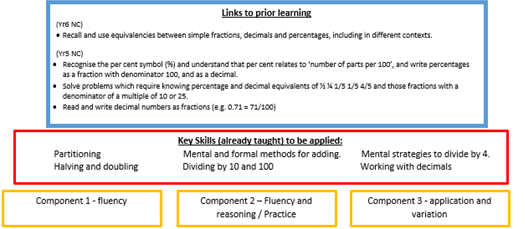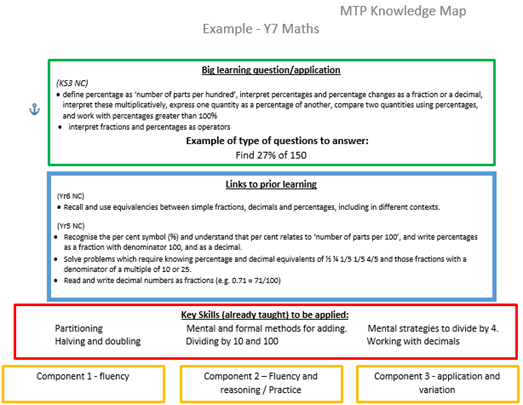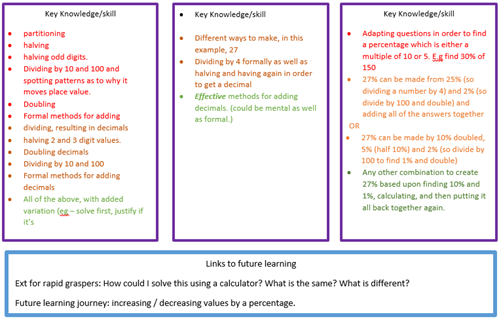April Blog 2022
Mixed Attaining teaching blog
I think one of the biggest misconceptions in preparing for and teaching a mixed attaining class, is the idea that you should focus on the lower attaining children and try to pull them up at the expense of the middle and higher attaining children. Focus should instead be placed upon the high expectation of all children; planning for the higher attainers (or at the least, the age related expectation of the class you are teaching), and from this, plan and provide a learning journey to allow the lower and middle attaining children to access that end goal. This (first) blog will focus on how this can be achieved through careful planning on the MTP template.
The Learning Journey
Example: Upper KS2 / Lower KS3 requirement to calculate a percentage of an amount:
Example question which would demonstrate students understanding in relation to these aspects of the National Curriculum statement. This example only partially covers part of a statement and should be considered more as part of a larger learning journey within Maths.
This should be what teachers consider the end goal of the learning journey to be with regards to knowledge, or skills, or both. (see image below)

Taken from National Curriculum and statements, specifically linked to the aspect of learning identified within the Big Learning Question / Application which should have already been achieved for a student to be considered ARE (working at Age Related Expectations).
Whilst this allows teachers to recognise prior learning and support planning their learning journey accordingly, it also provides an opportunity to see what may need further embedding / revision, especially for lower attainders and those who are not working at ARE. (see blue section of image below)

When considering the Key Skills, it is important to consider what skills the students need in order to solve the Big Learning Question / Application, but which are NOT explicitly linked to it. This will form the baseline of the learning journey; For lower attainers, it will be an opportunity to teach and embed these concepts in order to progress, whilst for the middle and higher attainers, provide an opportunity to embed concepts to a greater depth level, and which can be developed further through reasoning and problem-solving. (see red section of image below)

This is the bulk of the learning journey, starting with those key skills identified in Key Skills, though broken down into what would be appropriate for all student groups. Starting or revisiting the familiar should be always be starting point of each lesson (research – Rosenshine’s Principles), and whilst it might seem counterproductive to drop the learning back to what could be considered ‘easy’, this exposure to the familiar embeds and deepens knowledge, whilst also providing an opportunity for any child who is struggling to be exposed to / relearn a concept for a purpose. This model therefore lends itself perfectly for flexible groupings; responding to the needs of specific students/groups of students, and allowing time for more precise teaching of a concept, particularly for those students who may need additional support. In practice, whilst middle and higher attainers are embedding and deepening knowledge independently, the class teacher has that time to work with any lower attainers, or struggling students more practically. Don’t panic, as teased earlier, there is a follow-up blog on its way which will delve deeper into flexible grouping in practice, and how all of these concepts are able to fit together.
Looking back at the learning journey within this model, progression is demonstrated in two ways. The first is, as you work down though each component, tasks and learning should be progressive, allowing students to build and deepen understanding. Lower attainers would start on the red and build up, whilst more confident students could choose their starting point. The second way progression is achieved is by moving from left to right across the components which build upon previous learning.
With this taken into consideration, teacher workload does not need to be excessive, as tasks within Component 1 should be progressive as previously demonstrated, and regardless of the start / end point, would still allow all student groups to progress onto Component 2 and later Component 3. It should also be noted, that Component 1 could only be one lesson as a starting point, with Components 2 and 3 being more, allowing time to practice and embed. Should there still be students within the class who may not have confidently mastered concepts within Component 1, there is still that level of familiarisation needed to progress on to Component 2 and 3, and tasks within these components should still revisit these concepts - not only to maintain a level of familiarity and embedding, but to also encourage student’s reasoning in recognising what general skills they are applying to this specific problem. (see purple sections of image below)


This should be the next steps in the learning journey – what has this learning journey achieved in student’s understanding, and so what would this lend itself to next? Once, this is identified, you get to start the whole process again… (see blue sections underneath the purple section of image above)
